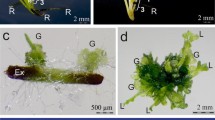Abstract
Anthers and ovules of Scabiosa columbaria L. were cultured in vitro to determine whether gametophytic cells would proliferate and/or a protocol for plant regeneration could be developed. Several factors were tested, including explant type, donor plant, cold pre-treatment, and medium composition. Callus induction frequency varied among treatments, indicated by significant effects of explant type, medium composition, and their interactions. Histological analysis revealed numerous sites of callus induction, however, gametophytic cells did not proliferate. Stepwise removal of growth regulators and simultaneous lowering of sucrose from the nutrient medium, resulted in initiation of embryogenesis or shoot organogenesis, and allowed plant regeneration. Under the conditions tested, regeneration capacity was donor related, because only material of one donor responded. Regenerants were diploid (except one mixoploid individual), but showed various types of flower heads. They were probably of sporophytic origin.
Similar content being viewed by others
References
Ackerman R & Hamernik H (1994) Giberellic acid to extend shoots and bud break on Heuchera and Scabiosa. Combined Proceedings International Plant Propagators' Society 44: 545-546
Ammirato PV (1986) Control and expression of morphogenesis in culture. In: Withers LA & Alderson PG (eds.) Plant Tissue Culture and its Agricultural Applications (pp 23-45). Buttersworths, London
Angenent GC, Franken J, Busscher M, Weiss D & van Tunen AJ (1994) Co-suppression of the petunia homeotic gene fbp2 affects the identity of the generative meristem. Plant J. 5: 33-44
Clarke GCS (1981) Staining procedures (pp 512). Williams and Wilkins, Baltimore
Ernst S, Scheibner K, Diettrich B & Luckner M (1990) Androgenetic cell cultures and plants from anthers of Digitalis lanata. J. Plant Physiol. 137: 129-134
Goldstein DB, Linares AR, Cavalli-Sforza LL & Feldman MW (1995) An evaluation of genetic distances for use with microsatellite loci. Genetics 139: 463-471
Holme IB & Petersen KK (1996) Callus induction and plant regeneration from different explant types of Miscanthus ogiformis Honda 'Giganteus'. Plant Cell Tiss. Org. Cult. 45: 43-52
Kachidze N (1929) Karyologische Studien über die familie der Dipsacaceae. Planta 7: 482-502
Lichter R (1981) Anther culture of Brassica napus in liquid culture medium. Z. Pflanzenphysiol. 103: 229-237
Mallait M (1988) Diversification des fleurs coupées par les plantes vivaces: La Scabieuse du Caucase; une espèce à promouvoir pour le plein champ. P.H.M.-Revue Horticole 284: 51-53
Murashige T & Skoog F (1962) A revised medium for rapid growth and bioassays with tobacco tissue cultures. Physiol. Plant. 15: 473-497
Nichterlein K, Umbach H & Friedt W (1991) Genotypic and exogenous factors affecting shoot regeneration from anther callus of linseed (Linum usitatissimum L.) Euphytica 58: 157-164
Nichols D (1992) Scabiosa, Scabiosa columbaria. Plant Varieties J. 4: 20-21
Oostermeijer G (1995) De levensvatbaarheid en het beheer van kleine plantenpopulaties: een reaktie. De Levende Natuur 96: 223-227
Ouborg NJ (1993) On the relative contribution of genetic erosion to the chance of population extinction. Cip-gegevens Koninklijke Bibliotheek, Den Haag
Ouborg NJ, Haeck J, Reinink K & van Treuren R (1995) Een methode voor de schatting van de levensvatbaarheid van populaties met Duifkruid als voorbeeld. De Levende Natuur 96: 46-52
Reinert J (1973) Aspects of organization-organogenesis and embryogenesis. In: Street HE (ed) Plant Tissue and Cell Culture (pp 338-355). Blackwell Scientific Publishers, Oxford
Schulte-Scherlebeck H (1996) Kulturinformation zu Scabiosa caucasica. Zierpflanzenbau 11: 480
Starman TW, Cerny TA & MacKenzie AJ (1995) Productivity and profitability of some field-grown specialty cut flowers. Hort Science 30: 1217-1220
Van Treuren R (1993) The significance of genetic erosion for the extinction of locally endangered plant populations. Cip-Data Koninklijke Bibliotheek, Den Haag
Van der Meijden R (1996) Heukels' Flora van Nederland. Wolters Noordhoff, Groningen, The Netherlands
Veilleux RF, Chen IY, Paz MM (1995) Analysis of the genetic composition of anther-derived potato by randomly amplified polymorphic DNA and simple sequence repeats. Genome 38: 1153-1162
Weeda EJ, van der Meijden R & Bakker PA (1990) Floron-Rode Lijst 1990: Rode Lijst van de in Nederland verdwenen en bedreigde planten (Pteridophyta en Spermatophyta) over de periode 1.I.1980-1.I.1990. Gorteria 16: 2-26
Author information
Authors and Affiliations
Corresponding author
Rights and permissions
About this article
Cite this article
Romeijn, G., van Lammeren, A.A. Plant regeneration through callus initiation from anthers and ovules of Scabiosa columbaria. Plant Cell, Tissue and Organ Culture 56, 169–177 (1999). https://doi.org/10.1023/A:1006215120206
Issue Date:
DOI: https://doi.org/10.1023/A:1006215120206




